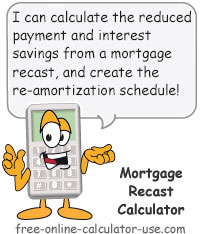IMPORTANT: Numeric entry fields must not contain dollar signs, percent signs, commas, spaces, etc. (only digits 0-9 and decimal points are allowed).
Click the Terms tab above for a more detailed description of each entry.
Step #1:
Enter the mortgage's current payoff amount.
Step #2:
Enter the mortgage's annual interest rate.
Step #3:
Enter the principal and interest portion of your monthly mortgage payment.
Step #4:
Select the month and year the next payment is due.
Step #5:
Select 1-time or Annual and enter the lump sum principal reduction you will be making based on your selection.
Step #6:
Enter the lender recasting fee.
Step #7:
Indicate whether or not you would like an amortization schedule included in the results (Yes or No).
Step #8:
Tap the "Calculate Recast Savings" button and scroll down to view the results.


Follow me on any of the social media sites below and be among the first to get a sneak peek at the newest and coolest calculators that are being added or updated each month.